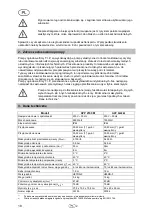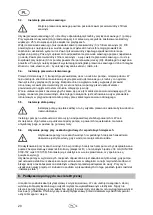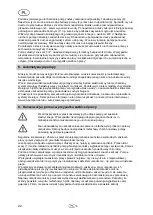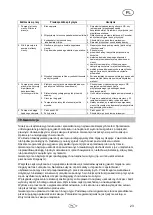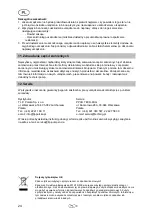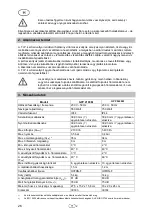
4
5.3.
Installation of the suction line
The intake of the suction line has to be equipped with a check valve (or non-return
valve) and an intake filter.
Please use a suction line (2) having the same diameter as the suction port (1) of the pump. If the
suction height (HA) exceeds 4 m, however, it is recommendable to use a 25% larger diameter -
including appropriate reducer elements for the connectors.
The intake of the suction line has to be equipped with a check valve (3) - or non-return valve - and an
intake filter (4). The filter will keep away larger dirt particles contained in the water which might clog or
even damage the piping. The check valve will prevent the pressure to escape after the pump has cut
out. Moreover, it simplifies the venting of the suction line by enabling water to be filled in. The check
valve with the intake filter - i.e. the entirety of the intake section of the suction port - must be immersed
by at least 0.3 m below the surface of the liquid to be pumped (HI). This will prevent air from being
taken in. In addition, please ensure a sufficient distance of the suction line from both the ground and
the sides of water courses, rivers, ponds etc in order to prevent stones, plants etc from being sucked
in.
5.4.
Installation of the pressure line
The pressure line (11) conveys the liquids to be discharged from the pump to the point of withdrawal.
To avoid dynamic flow losses, one should use a pressure line having at least the same diameter as
the pressure port (5) of the pump. To protect the pump from damage caused by pressure surges it is
advisable to equip the pressure line with a check valve (6) to be installed directly downstream the
pump outlet.
Also, to facilitate maintenance work, it is recommendable to install a shut-off cock (7) after the pump
and check valve. This is a useful feature since it can be closed when the pump has to be dismantled
and will thus prevent the pressure line from draining to empty.
5.5.
Using the pump for garden ponds and similar places
Operating the pump next to garden ponds and similar places is generally only
admissible if no persons are in contact with the water.
If the pump is used for garden ponds and similar places it has to be operated using a residual current
circuit-
breaker (FI switch) with a nominal trigger current of ≤ 30mA (DIN VDE 0100-702 and 0100-
738). Please ask your electrical services provider whether your installation site complies with this
condition.
The pump must not be used in such locations unless it is set up firmly and flood-proof, a minimum
distance of two metres away from the border of the water body and secured against falling into the
water by a solid holding device. For this purpose the device is to be bolted down firmly to the ground
at the fastening points provided (please refer to the chapter titled "Stationary installation").
6. Electrical connection
The unit is equipped with a mains connection cable and a mains plug. It must only be replaced by
qualified staff to avoid any danger. Please do not use the mains connection cable to carry the pump,
and do not use this cable to pull off the plug from the socket, either. Protect the mains connection
cable and mains plug from heat, oil or sharp edges.
The values stated in the technical details have to correspond to the mains voltage.
The person responsible for the installation has to make sure that the electrical
connection is earthed in compliance with the applicable standards.
The electrical connection has to be equipped with a highly sensitive residual current
circuit-
breaker (FI switch): ∆ = 30 mA (DIN VDE 0100-739).
Only use an extension cable with a cable section (3 x 1.0 mm²) and rubber sheath
which at least corresponds to that of the unit's own connection cable (see "Technical
data", cable type) and which is labelled with the relevant abbreviation according to
the VDE (German Association for Electrical, Electronic & Information Technologies).
The mains plug and other connections must be splash proof.
12
Summary of Contents for GPP 2100 M
Page 106: ...Notizen notes note notas ...
Page 107: ...Notizen notes note notas ...




















